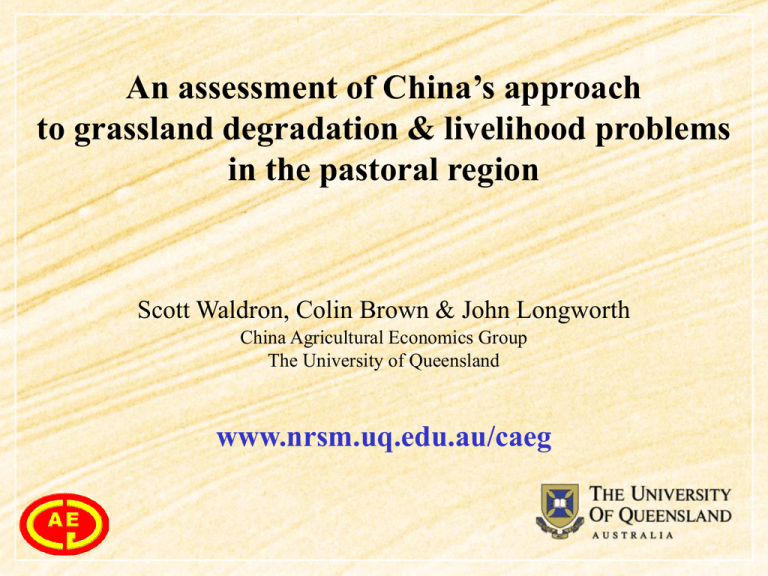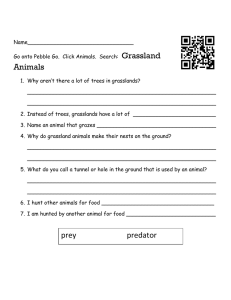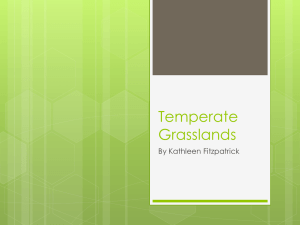An assessment of China’s approach to grassland degradation & livelihood problems
advertisement

An assessment of China’s approach to grassland degradation & livelihood problems in the pastoral region Scott Waldron, Colin Brown & John Longworth China Agricultural Economics Group The University of Queensland www.nrsm.uq.edu.au/caeg Presentation 1. The problem • • 1 (a). Grassland degradation 1 (b). Pastoral livelihoods 2. The “fixes” • • • 2 (a). Technical fixes 2 (b). Administrative fixes 2 (c). Management fixes 3. Assessment • More emphasis needed on the latter - “management fixes” 1 (a). Levels of grassland degradation Severity of degradation – Inner Mongolia Period Light Medium High 1980s 47% 35% 17% 2003 31% 37% 32% Source: Lu (2005) 1 (a) Causes of degradation • Non-livestock grazing pressure – Rodents – Insects • Exposure of topsoil – Herb picking – Rip lines for tree planting & artificial grasses – Cultivation / land reclamation !!!! • But consensus that over-grazing of livestock is the main cause!!!! 1 (a) Levels of overgrazing Seasonality is an issue Province / AR Qinghai Tibet Xinjiang Inner Mongolia Seasonal grassland type Actual Stocking Capacity as a % of Theoretical Stocking Capacity Warm season grasslands 107% Cold season grasslands 183% All grasslands 191% Warm season grasslands 124% Cold season grasslands 377% All grasslands 242% Warm season grasslands 164% Cold season grasslands 226% All grasslands 249% All grasslands 330% Source: Lu (2006), with updates and re-estimates as explained in Brown et al. (2008, Table 2.7). • Winter-spring grasslands heavily over-grazed • Summer grasslands less heavily grazed & sometimes under-grazed 1 (b). Pastoral incomes Inner Av. rural incomes for province – rank in China Mongolia Tibet Gansu Qinghai Xinjiang 17 29 30 26 25 115% 119% 110% 122% 117% 99 81 74 99 70 81% 115% 90% 100% 79% 83 35 32 88 41 Pastoralists in pastoral counties Income as a % of av. rural incomes Pastoral activity as % of incomes Pastoralists in semi-pastoral counties Income as a % of av. rural incomes Pastoral activity as % of incomes Source: China Animal Husbandry Yearbook, 2006 1 (b). Pastoral livelihoods • But income data masks other livelihood determinants • Pockets of poverty • Lack of access to – Services (education, health, medical) – & infrastructure (housing, power, roads) • Justification for nomad settlement & resettlement 1 (a,b). The grassland degradation–low income cycle Households & collectives respond by increasing livestock numbers Low incomes Low productivity Over-stocking of grasslands Population pressure Grassland degradation & cultivation Declining resource base • How is China attempting to break the cycle? • How can this approach be improved? 2. “Fixes” to break the grassland-livelihood cycle • China turning attention to urgent problems – Rmb100 billion investment in the grasslands from 1998 to 2005 – In the full range of programs that impact on grasslands • “Fixes” can be classed as: – Technical – Administrative – Management 2 (a). Technical measures • To increase grassland productivity – Grassland seeding and improvement • To reduce non-livestock grazing pressure – Rodent and insect control • To exclude livestock and secure property rights – Fencing • Other infrastructure – E.g. Dips, market places and shearing sheds • To intensify livestock systems !!!!!! – Pen-feeding, feed, flock structures and breeding 2 (b). Administrative fixes • Technical fixes complemented by strengthening of administrative measures • On the basis that local level systems (collective-individual co-management) have failed • So the State is assuming control! 2 (b) Policy and legislative framework sets direction Edicts SC Grassland MoA Opinion Grassland Plan Top-down direction Legislation Agricultural law Vertical coordination across administrative levels & instrument specificity AntiGrassLivedesertif land stock ication law law law provides legislative framework Regulations & standards Grasslandlivestock balance management method Grasslandfire prevention regulations Grasslanddegradation monitoring technical rules provides funding & sets particular parameters Programs Bottomup implementation Grassland Natural Protected Area Pastoral water hydrology Artificial Grassland Construction Natural Grasslands revegetation & Construction Reduce Combating livestock desertifireturn cation grasslands Nomad Settlement BeijingTianjin Desertification Disaster control and prevention Implementation & actual measures Horizontal co-ordination across regulations and programs Fencing reflects incentives & circumstances 2 (b). “Reduce livestock return grasslands” • Set aside program like “Grain for Green” • Grazing bans & compensation payments – Whole year bans, whole year pen-feeding – Or seasonal bans – especially spring grasslands – Average of 5 years per area / household – Will be rolled out throughout the entire pastoral region!!! 2 (a,b). Technical & administrative fixes: • Designed to get people & livestock off the grasslands!!! – Intensify livestock systems – Settlement & resettlement – Increase off-farm labour, migration & on-leasing • Like the rest of rural China!!! 2 (a,b). Technical & administrative fixes • Provide immediate solutions to immediate problems • But it is simply not logistically possible to implement, enforce & maintain over 400 million ha. of variable and inaccessible county • Need to be complemented with long-term, bottom-up measures • i.e. Termed as management fixes 2 (c). Management fixes • Seasonal turnoff cycles reduce pressure on cold season grasslands • But in the context of an increase in year-end livestock numbers • Maintains pressure on grasslands &/or cultivated land 6000 5000 '000 head 4000 3000 2000 1000 0 Jul00 Jan01 Jul01 Jan02 Jul02 Cattle Jan03 Jul03 Goats Jan04 Jul04 Jan05 Jul05 Sheep Inner Mongolia mid and end year stock numbers Source: Inner Mongolia Autonomous Region Bureau of Statistics (various years) 2 (c). Household level production decisions • More responsive management practices include: – Increasing turnoff rates of offspring – for slaughter & to agricultural areas for finishing – Culling unproductive breeders – animal selection • Trials / modelling show that destocking/selection can be offset by productivity gains – income neutral or gains – To increase livestock value per unit grazing pressure • But these initiatives require – Change in “traditional systems” (while maintaining “indigenous knowledge”) – Better farm management capacity - empowerment of herders – Which are under-emphasised in State extension & training programs • However not all households will be able to adapt – Zhuanyi & on-leasing – Which involves another series of skills, language & training issues 2 (c). Integration of households into markets • Targeting production – To meet the demands of specific markets in which pastoral areas have a comparative advantage • – • E.g. Hot Pot, green food, textile markets These can be higher value markets and can increase household revenues But meeting these market demands requires – Better farm management skills • – The development of effective local groups (associations, cooperatives) • – As discussed above For the production & assembly of homogeneous lines of product The development of an efficient marketing system • That engenders price-grade differentials • All of which are highly undeveloped in the pastoral region & largely neglected • Initiatives required Decentralisation Centralisation Centralisation-decentralisation (zhua-fang) cycles in grasslands management Central Planning era Central Planning era - 1950-80s HPRS, marketing reforms Policy & legal interventions Post reform era - 1980-1990s 2000-mid term future Increased mangement capacity required - on-farm and off-farm Mid-longer term future 2 (b). Nomad settlement Inner Mongolia Tibet Gansu Qinghai Xinjiang 100 16 88 93 77 1 -325 6 19 8 100 56 12 75 79 0 48 --- -19 90 Pastoralists in pastoral counties % settled households – 2005 % change in % of settled households 2000-2005 Pastoralists in semi-pastoral counties % settled households – 2005 % change in % of settled households 2000-2005 Source: Animal Husbandry Yearbook, 2001, 2006 • And many more cases of resettlement





